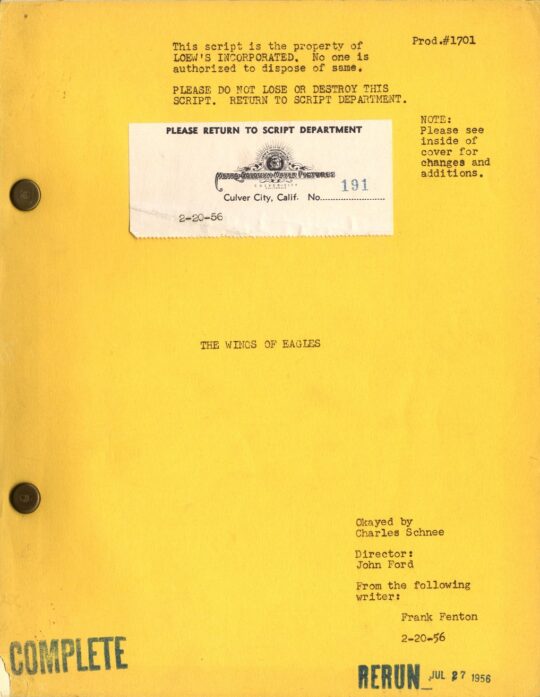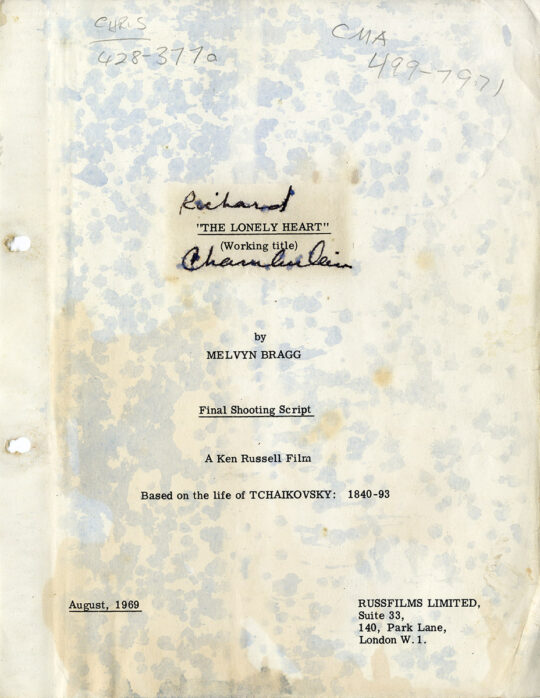DOG DAY AFTERNOON [1973] Film script
New York, [1973]. Vintage original film script, 11 x 8 1/2″ (28 x 22 cm.), 128 pp. Script has name of Phil Leto, the film’s makeup artist, on front cover. A few pages have underlinings in Leto’s hand. Mimeographed script, complete as issued without title page, in Studio Duplicating Service leatherette wrappers, which are affixed to a spring binding within plain green wrappers and then attached to the binding with masking tape. Script is fine, leatherette wrappers have chipping at edges, spring binding shows light signs of use, overall fine in very good wrappers and outer binding.
Dog Day Afternoon was the second collaboration of film producer Martin Bregman, director Sidney Lumet, and star Al Pacino, following the success of their first joint effort, Serpico (1973). Like Serpico, the movie of Dog Day Afternoon was based on fact — a bank robbery that occurred in Brooklyn, NY, on a hot August day in 1972. The Academy Award-winning screenplay was by Frank Pierson, whose prior credits included Cat Ballou (1965), Cool Hand Luke (1967), and Lumet’s The Anderson Tapes (1971).
Like many of director Lumet’s best movies (e.g., 12 Angry Men), Dog Day Afternoon is a “closed system ensemble film”, a film with a tight ensemble of actors that takes place within a circumscribed area within a circumscribed period of time. In the case of Dog Day Afternoon, almost all of the significant action takes place inside a bank and on the Brooklyn city block outside the bank within the space of a single afternoon and evening.
Inside the bank, we have an ensemble consisting of two robbers, Sonny (Al Pacino) and Sal (John Cazale), a bank manager, a black security guard, and seven female employees. Outside the bank we have a harried police lieutenant (Charles During), two FBI men, a crowd of hundreds including police and other onlookers (played mostly by professional New York actors), and three of the people closest to robber Sonny: his female wife (Susan Peretz), his male wife (Chris Sarandon), and his mother (played by legendary Living Theater co-founder Judith Malina).
Like many of director Lumet’s best movies (The Pawnbroker, Serpico, Prince of the City), Dog Day Afternoon is a quintessential New York film. Critic Pauline Kael called it “one of the best ‘New York’ movies ever made.”
Producer Bregman, director Lumet, and star Pacino agreed that Frank Pierson’s original screenplay was “brilliant”, and the movie follows it scrupulously — with one significant difference. In his quest for absolute naturalism, Lumet told his core ensemble during their three weeks of rehearsal that they should not play “characters” but should be themselves. One actor responded, “Can we use our own words?”, and director Lumet agreed, allowing the actors to improvise around the written dialogue. Their improvisations were recorded, and much of their improvised dialogue was incorporated into a final shooting script.
The other major difference between this screenplay and the completed film was the final telephone conversation between Sonny and his male wife, Leon. That part of Pierson’s screenplay is intentionally left blank with the note “Dialogue between Sonny and Leon to be written”, and was ultimately scripted based on the improvisational work of actors Pacino and Sarandon.
The movie is alternately hilarious and moving, a tragic comedy of errors that deftly interweaves several significant thematic threads:
– LGBTQ issues: Producer Bregman claimed that “no major star had ever played a gay”, and while there had been gay characters in movies played by major actors before, those portrayals were generally “coded” and resorted to stereotypes. There were no stereotypes in Pacino’s characterization as scripted or portrayed. In fact, members of the audience who were not previously aware of Sonny’s orientation were utterly surprised when they learned of it approximately halfway through the movie, complicating their attitude toward the character, just as many of the onlookers within the movie, who had unambiguously supported Sonny up to that point, reevaluate their response to the character, some of them turning against him. Moreover, Dog Day Afternoon was arguably the first Hollywood film to portray a transsexual — soon after we learn about Sonny’s male wife, Leon, we learn that Sonny’s principal motivation for the robbery was to purchase Leon a sex-change operation.
– Media circus: Dog Day Afternoon is not just about a bank robbery. It is just as much about the media circus that surrounds the bank robbery, particularly the non-stop television coverage and how it affects the participants — the way Sonny plays to the television cameras and the crowd, the way a boy who delivers pizza to the hostages turns to the cameras and shouts, “I’m a star!” — its effect on law enforcement, and its effect on all of us. It’s a theme that Lumet would explore further in his next film, Network.
– Stockholm Syndrome: One of the most intriguing (and true) aspects of the story is how the bank employees came to bond with the robbers who held them hostage (just as the actors bonded with each other during their three weeks of rehearsal). We see Sonny, a Vietnam vet, handing a rifle to one of the employees and teaching her how to present arms. In one of the script and film’s most moving moments, just before the robbers and their hostages are supposed to board a plane, Sonny sets one of the hostages, Maria, free, and she hands the other robber, Sal, her rosary because she knows he is afraid of flying.
To counter the outrageousness of its true story, Lumet strove to make Dog Day Afternoon the most naturalistic movie he ever shot. There’s no music other than a song heard on the radio during the opening credits. The actors wore their own clothes. All the lighting comes from natural sources. Frank Pierson’s inspired and superbly structured screenplay won not only an Oscar, but the Writers Guild of America Award for Best Drama Written Directly for the Screen. Today, the film stands as a masterpiece of the 1970s American New Wave.
Out of stock
Related products
-

LOOT (ca. Sep 1969) Final Draft screenplay
$1,500.00 Add to cart -

WINGS OF EAGLES, THE (1957) Two variant film scripts
$2,650.00 Add to cart -

Ken Russell (director) THE MUSIC LOVERS [working title: THE LONELY HEART] (1969) Final shooting script
$3,000.00 Add to cart -

(African American film) A PIECE OF THE ACTION [working title: SOMETHING BIG COMING UP] (Nov 1, 1976) Film script
$750.00 Add to cart

![DOG DAY AFTERNOON [1973] Film script](https://www.walterfilm.com/wp-content/uploads/2024/06/DogDayAfternoonSCR_a.jpg)
![DOG DAY AFTERNOON [1973] Film script - Image 2](https://www.walterfilm.com/wp-content/uploads/2024/06/DogDayAfternoonSCR_b.jpg)
![DOG DAY AFTERNOON [1973] Film script - Image 3](https://www.walterfilm.com/wp-content/uploads/2024/06/DogDayAfternoonSCR_c.jpg)